History of Haryana
Haryana is a state in India. During the British Raj period it was administered as a part of the Punjab province. It became a separate administrative entity in 1966.
Chronological history
Vedic period
In some ancient Hindu texts, the boundaries of Kurukshetra correspond roughly to the state of Haryana. Thus according to the Taittiriya Aranyaka 5.1.1., the Kurukshetra region is south of Turghna (Srughna/Sugh in Sirhind, Punjab), north of Khandava (Delhi and Mewat region), east of Maru (desert) and west of Parin.[1]
Pre-Islamic Hindu-Buddhist period
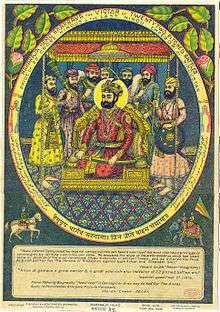
After ousting the Huns, king Harshavardhana established his capital at Thanesar near Kurukshetra in the 7th century CE. After his death, the kingdom of his clansmen, the Pratiharas ruled over a vast region for quite a while from Harsha's adopted capital Kannauj. The region remained strategically important for the rulers of North India even though Thanesar was no more as central as Kannauj. Prithviraj Chauhan established forts at Taraori and Hansi in the 12th century.
Sultanate period
Muhammad Ghori conquered Haryana after the Second Battle of Tarain. Following his death, the Delhi Sultanate was established that ruled much of India for several centuries. The earliest reference to 'Hariana' occurs in a Sanskrit inscription dated 1328 AD kept in Delhi Museum, which refers to this region as The heaven on earth, indicating that it was fertile and relatively peaceful at that time. Firoz Shah Tughlaq established a fort at Hisar in 1354 to further fortify the region, and also constructed canals or rajwahas as they were referred to in the Indo-Persian historical texts.
The three famous battles of Panipat took place near the modern town of Panipat. The first battle took place in 1526, where Babur, the ruler of Kabul defeated Ibrahim Lodi of the Delhi Sultanate, through the use of field artillery. This battle marked the beginning of the Mughal empire in India.
In the Second Battle of Panipat (5 November 1556), Akbar's general Bairam Khan defeated Hemu, the local Haryanvi who grew up in Rewari. Hemu, who belonged to Rewari in Haryana, rose from a businessman to become advisor to Afghan kings and then Prime Minister-cum-Chief of Army. He fought and won 22 battles in between 1553 and 1556, from Punjab to Bengal against Afghans and Mughals and won all of them without losing any. Hemu defeated Akbar's army at Tughlaqabad in Battle of Delhi-1556 and became king at Delhi on 7 October 1556 declaring himself as Vikramaditya following the reigns of earlier Vedic kings.[2] Hemu lost his life in the Second Battle of Panipat.
Maratha period (1756-1801)
The Third Battle of Panipat was fought in 1761 between the Afghan warlord Ahmad Shah Abdali and the Maratha Empire under Sadashivrao Bhau of Pune. Ahmad Shah won decisively, on 13 January 1761.
Colonial period
During the first war of independence in 1857 the major centers of rebellion were at Hisar, Hansi, Sirsa, Rohtak, Jhajjar, Bahadurgarh, Farrukhnagar, Ballabhgarh, Rewari, Ambala, Panipat and Thanesar.[3] Under the "Delhi Agency" there were seven princely states, Jhajjar, Farrukhnagar, Ballabhgarh, Loharu, Pataudi and Dujana. The Chiefs of the last two estates remained loyal to the British and others rebelled.[4] The Rajput rulers of Rajasthan also kept out of the mutiny.[5] Raja Nahar Singh the Jat ruler of Ballabhgarh, Rao Tula Ram ruler of Rewari and his cousing Gopal Dev, Nawab Abdur Rahman Khan Jhajjar, Nawab Ahmad Ali of Farrukhnagar, Sadruddin the peasant leader of Mewat, Harsukh Rai and Mirza Gauhar Ali of Palwal and Imam of Bu Ali Shah Qalandar mosque in Panipat played key role.[3]
5th and 60th Regiments of Benga Native Infantry rebelled at Umballa (Ambala). During the Battle of Narnaul at Nasibpur on 16 November 1857, British lost 70 British soldiers and their commanders colonel Gerrard and Captain Wallace. 40 British soldiers and officers Captain Craige, Captain Kennedy and Captain Pearse were wounded.[3]
Independence and formation of Haryana
On 1 November 1966, Haryana was carved out on the basis of that the parts of Punjab which were to be Haryana's "Hindi-speaking areas." Same example was followed in creation of Himachal Pradesh as well. Haryana state was formed on the recommendation of the Sardar Hukam Singh Parliamentary Committee. The formation of this committee was announced in the Parliament on 23 September 1965.
On 23 April 1966, acting on the recommendation of the Hukam Singh Committee, the Indian government set up the Shah Commission under the chairmanship of Justice J. C. Shah, to divide and set up the boundaries of Punjab and Haryana.
The commission gave its report on 31 May 1966. According to this report the then districts of Hissar, Mahendragarh, Gurgaon, Rohtak, and Karnal were to be a part of the new state of Haryana. Further the Tehsils of Jind (district Sangrur), Narwana (district Sangrur) Naraingarh, Ambala and Jagadhari of district Ambala were also included. The commission recommended that Tehsil Kharar (including Chandigarh) should also be a part of Haryana.[6]
Theme history of Haryana
Railway
Railway in Haryana falls in 2 railway zones (Northern Railway zone and North Western Railway zone), and 3 divisions under those.
Aviation
Roads transport
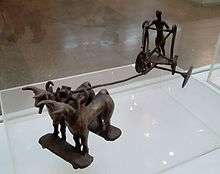
GT Road with Kos Minar and Caravanserais
Electricity
Municipalities
Agriculture
Irrigation
- Western Yamuna Canal
- Bhakhra Dam
- Indira Gandhi Canal
- Tajewala Barrage (1873)
- Nuh System of Lakes with bund built by British Raj
- Johad wetlands and Haryana State Waterbody Management Board
Architecture
- IVC Black and red ware culture (1450BCE-1200BCE)
- Vedic Era Painted Grey Ware culture (1200BCE to 600BCE)
- Pre-Islamic architecture of Haryana
- Bhima Devi Temple Site Museum
- Kalayat Ancient Bricks Temple Complex
- Adi Badri, Haryana
- Morni Hills Shiva temple
- Pillars of Ashoka in africa.
- Topra Kalan pillar relocated as Delhi-Topra pillar at Feroz Shah Kotla
- Agroha Mound pillar relocated to Lat Mosque Hisar (bottom half)) and Fatehabad mosque (top half)
Nangal Sirohi in Mahendragarh district, 130 km from Delhi, is popular for its havelis of shekhavati architecture within NCR.[7]
Mining
Industries
Clothing and textiles
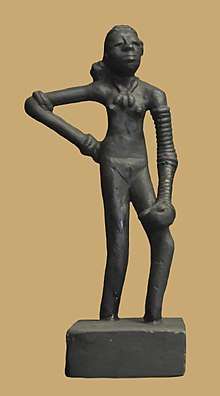
Dancing Girl attire.
Ornaments and jewellery
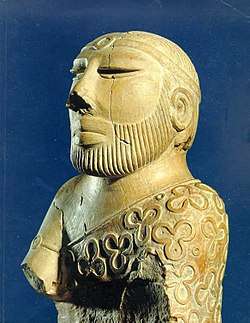
Rakhigarhi silver bronze ornaments finds and Dancing Girl ornaments.
Education
Chanetic Buddhist monastic university as chronicled by Hieun Tsang.
Sports
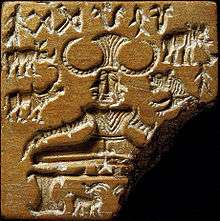
Pashupati Shiva in yoga pose from Indus Valley Civilization.
Princely states
- States at the time of independence
- With headquarter based in Haryana
- Jind State of Phulkian Misl Sandhu Jat Sikhs
- Loharu State
- Buria State of Jat Sikhs (move to abolished?)
- Kunjpura State of Nawab (move to abolished?)
- Dujana State of Nawab (move to abolished?)
- With headquarter based outside of Haryana with parts of territory within Haryana
- Nabha State of Phulkian Misl Sandhu Jat Sikhs
- Patiala State of Phulkian Misl Sandhu Jat Sikhs
- Malerkotla State of Nawab
- With headquarter based in Haryana
- Abolished states, such as due to Indian Rebellion of 1857 or for other reasons.
- Ballabhgarh State of Tewatia Jats.Abolished after 1857 revolution and Raja Nahar Singh hanged to death by britishians
- Jhajjar State of Nawab
- Farrukhnagar State of Nawab
References
Citations
- ↑ Agarwal, Vishal: Is There Vedic Evidence for the Indo-Aryan Immigration to India? (PDF) Archived 28 May 2008 at the Wayback Machine.
- ↑ Kar, L. Colonel H. C. "Military History of India", Calcutta (1980), p.283
- 1 2 3 Dr Malti Malik, History of India, Page 356.
- ↑ Madan Gopal, 1977, Sir Chhotu Ram: a political biography, Page 9.
- ↑ M.K. Singh, 2009, Encyclopaedia Of Indian War Of Independence (1857-1947) (Set Of 19 Vols.)
- ↑ "1st November 1966 - Haryana Day - History - Haryana Online - North India" Archived 2 October 2013 at the Wayback Machine.
- ↑ Magnificent havelis of Nangal-Sirohi, The Tribune, 22 June 2002.
Further reading
See also
External links